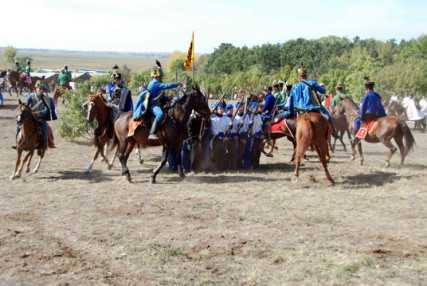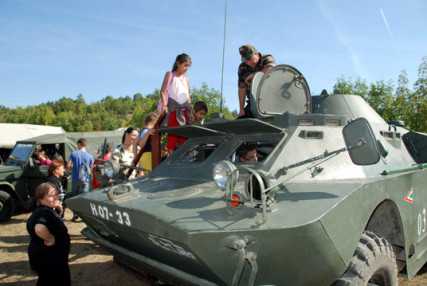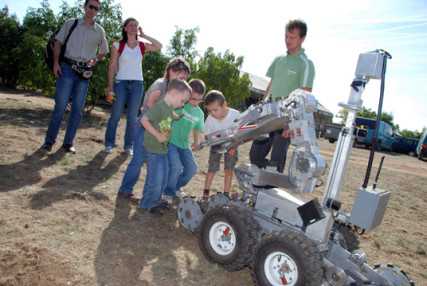“Pákozd Is The Symbol Of The Nation Joining Forces, And Military Honour”
Szöveg: László Szűcs | 2009. október 9. 6:19The battle of Pákozd-Sukoró that took place 161 years ago was commemorated this Sunday, on the Day of Land Forces at the memorial on Mészeg Hill. At the festivity held on the former battlefield heritage military groups reconstructed the events of the battle.
The Ministry of Defence, the Székesfehérvár Branch of the Defence Forces and Society Friendly Association, the HDF Joint Forces Command, the Hungarian Hussar and Military Heritage Alliance, and the Pákozd Military Memorial Committee organized a nearly all-day program this Sunday at the former battlefield close to Lake Velence.
The military vehicles and the technical equipments used by the Hungarian Defence Forces were lined up at the foot of Mészeg Hill and were invaded by a gaggle of children in the early morning hours. Some kids liked the chemical-nuclear reconnaissance combat vehicle the most, while others preferred the EOD robot. Nevertheless, everyone agreed that it was a great adventure to climb into the vehicles.
For the 29th of September – the anniversary of the battle of Pákozd – has also been celebrated as the Day of the Land Forces since 2006. (In earlier years, until 1992, the anniversary of the battle of Pákozd-Sukoró had been celebrated as the Day of the Armed Forces.) And on this occasion the technical equipments of the land forces were also on display.

A vast number of visitors turned up at the tent of Magyar Honvéd magazine as well where they could talk to the journalists and those who filled in the ‘picture shooting gallery’ correctly were given valuable prizes. The more courageous had a chance to try the aircraft simulator in the recruitment coach of the HDF Zrínyi Communications Non-profit Co. – one of the main sponsors of the event –, and those interested in military literature could purchase older and recently published volumes of Zrínyi Publishing House. Who were hopelessly ’out of ideas’ could take a look at the tents of the model-builders or the military heritage groups.
In his opening address Major-General János Kovács, Deputy Commander, HDF Joint Forces Command said that in this very moment there are a thousand Hungarian soldiers participating in peacekeeping operations in a number of places all over the world, and the majority of the personnel has been provided by the land forces.
– This day is a celebration that is exemplary as regards the way it expresses both in content and in its external manifestation how our history and our national defence traditions are fostered. Just like a nation lives in its history, the spirit of the modern Hungarian military of today is also built on honourale traditions that have to be saved – said Major-General Kovács, then the participants paid tribute with a minute of silence to those troops of the land forces who had fought for the country during the past centuries and sacrificed the most valuable thing, their lives for the country.
The official program began at 10 o’clock in the morning. The family, the current command of the Hungarian Defence Forces, and former comrades laid wreaths on the memorial plaque of General Dr. Béla Gyuricza, the life chairman of the Defence Forces and Society Friendly Association – the organizer of the event. General (ret.) Lajos Fodor, a former chief of the defence staff underlined in his eulogy that it has been ten years now since the Defence Forces and Society Friendly Association invites its members to this venue on 29 September to pay tribute to the soldier, the politician, the man who had inscribed his name upon the pages of history with his charismatic personality.
Following the evocation of the career of General Béla Gyuricza, Lajos Fodor emphasized: the general would have turned seventy this year, but it’s been ten years now since he is no longer with us.
– The place where we are now is symbolic, for 1848 was a turning point in the fate of national defence because it was then and here, in this meadow that the Hungarian army of that time had amalgamated and gone through baptism by fire. For more than ten years now the Hungarian Defence Forces have been officially regarding the army established in 1848 and engaging its first national defence fights their legal predecessor – said Lajos Fodor.
An hour later a wreath-laying ceremony was held at the renovated memorial of the battle of Pákozd. The previous winter had seriously damaged the memorial on Mészeg Hill and this summer the Pákozd Military Memorial Committee launched a fund-raising initiative among the citizens, business and social organizations in order to collect the necessary amount for the renovation. The Ministry of Defence was the first to support the cause with 2 million forints, and further donors, private individuals, active and retired servicemen, military organizations, corps, unions, and municipalities have also contributed. Among others, Chief of Defence Staff László Tömböl and his wife, Mr Tihamér Warvasovszky, the mayor of Székesfehérvár, and Lieutenant-General Tibor Benkõ, HDF JFC Commander have also contributed to the renovation of the memorial as private individuals. And – together with many other organizations – the HDF Zrínyi Communications Non-profit Co. has also offered an amount for the renovation of the obelisk.
At the ceremony held with full military honours Mr János Takács, the mayor of Pákozd greeted the guests. Like he said this place has become the symbol of the Hungarians’ love of freedom. It carries the message that our nation has always had prominent events we can remember proudly. The mayor added: there is currently an extensive development in progress in this area and the entire memorial will probably open next March. On 6 October the memorial site of the martyrs, the fourteen wooden headboards will be inaugurated.
– The obelisk where we are standing now had been damaged by spring and it had to be renovated. A public donation campaign had to be organized in a short time. And owing to the donations, today we can celebrate in front of the renewed obelisk and pay our tribute – said the mayor, adding that the names of the donors have been engraved in a memorial plaque at the monument. János Takács specially thanked Mr István Orgovány, the chairman of the Pákozd Military Memorial Committee for having organized the renovation of the obelisk.
Mr Tihamér Warvasovszky, the mayor of Székesfehérvár and the chairman of the Székesfehérvár Branch of the Defence Forces and Society Friendly Association emphasized in his opening address: now we are remembering an event in Hungarian history that had determined our history in many regards. For in that crucial moment it was indeed the fate of the homeland that was at stake. The multinational and multilingual troops making up the armies became the true defenders of the homeland, and worthy of the ‘honvéd’ (lit.: a soldier in charge of national defence) title.
The mayor added: during the past 161 years the battle has been interpreted in many ways. However, the nation has to have memorials where the visitors can contemplate in silence what happened in the past centuries.

– Pákozd and Sukoró are such places. This is exactly why the Székesfehérvár Branch of the Defence Forces and Society Friendly Association initiated in 1997 that the memorial the condition of which was unworthy at that time should be developed into a site that is worthy of our past and the spirit of which contributes to strengthening our patriotism and our love of the country – said Tihamér Warvasovszky, adding that he firmly believes that this is the place which can be truly worthy of thinking of the Hungarian soldier. The millions of Hungarians who, either deliberately or on order, joined the army upon the call of the country and did what they had to do. They fought and sacrificed their lives for their country.
– We do not make secret of our aim, and we are also working on it that the National Assembly should qualify this place a national historic memorial – said the mayor of Székesfehérvár in his opening speech, emphasizing: the Friendly Association renovated the memorial in 2002 from public donations, but due to various problems it was damaged again, therefore this year they had to contact the supporters once more. At the end of his speech Tihamér Warvasovszky thanked the Ministry of Defence, the Memorial Committee, and every supporter for their contribution.
Following the mayor’s speech Chief of Defence Staff General (eng.) László Tömböl delivered an address. The general underlined that the ravages of time have left their marks on the obelisk erected to commemorate the historic event of 161 years ago, but it is a natural process. Nevertheless, it is great to see that as a result of an extensive cooperation, today the memorial awaits in its old splendour those who come here to celebrate and remember.

– The obelisk of the Pákozd Military Memorial is the memento of a very important event in the history of the Hungarian nation: the defence of the achievements of the 1848 revolution, and the happenings at the beginning of the fight for freedom, that took place 161 years ago. For today Pákozd has become the symbol of the country, the symbol of progress, and of the efforts to gain independence from under foreign rule – said General László Tömböl, adding: in the historic game of fate Hungary has always had to link its revolutionary transformation processes with a fight for independence.
General Tömböl recalled the historic days when in the spring of 1848 the emperor’s court, due to the unfavourable turns of international power relations, had no choice but to pretend to accept the Hungarian revolutionary efforts, but by the end of the summer the web of intrigue had been completed. And since the Hungarian independence process had escalated to a level by that time that the consequences of putting an end to it by open military attack could not have been taken, the court wanted to make use of the anti-Hungarian movements in reaching its objectives. Having relied on the secret funds and ordnance of the Vienna ministry of war, Jelacic, the Croatian ban (governor) prepared for the invasion of Hungary. As the first step, on 31 August he invaded Fiume, then headed for Buda.
In his address the chief of the defence staff also mentioned that Pákozd is the symbol of the nation joining forces, of military honour, and moral superiority, as well as professional superiority and expertise. In spite of the fact that has been proven by historians: the battle of Pákozd was not of the same scale of the battle of the Catalaunian Plains, however, its political significance had outgrown its military achievements. The first battle of the Hungarian fight for freedom had become a symbol as a result of its political and moral impact. With their victory, the newly established national army had saved the capital, and together with that, the revolution. The military success gave both the revolutionary command and the soldiers assurance and self-confidence.
– The 29th of September, the anniversary of the victory at Pákozd, is an illustrious day that is celebrated every year, and it has strong ties with the history of the Hungarian military. The late successors of the Pákozd victors, the land forces of the Hungarian Defence Forces have their corps celebration on this day. The Day of Land Forces commemorates the strenuous and eventful past of the branch and it calls attention to the changes in our days and our everyday tasks. Since the change of the political system the entire military and within that, the land forces have lived through a period of continuous transformation, change. In addition to the transformation as regards the number of personnel and the structure, significant modifications have been made in the set of tasks and capabilities of the branch. Besides the traditional assignments, the international exercises and our participation in peacekeeping and crisis management entail new challenges. However, these new challenges can be met only with a modernized military. Naturally, this also means that new tasks require new capabilities, structures. An excellent example of the trial of the new structures and capabilities was Deployment Direction 2009, the joint service tactical exercise that involved all branches, conducted recently, where the land forces have proven their preparedness – said General László Tömböl.
The event closed with the Ministry of Defence, the Fejér County Municipality, the municipality of Szekesfehervar city with county authority, the HDF Joint Forces Command, the Fejér County Police Headquarters, the Fejér County Disaster Prevention Directorate, and the Székesfehérvár Branch of the Defence Forces and Society Friendly Association – among others – laying their wreaths of remembrance on the memorial.
Following the formal part of the all-day event the hussar and military heritage groups recalled the battle that took place 161 years ago. Zoltán Babucs, the colleague of the MoD Institute and History of Military Science, who also acted as a narrator, told the audience that the battle had in fact begun on the 28th of September, when the war council held in the Lutheran church of Sukoró had decided after a long debate that Lieutenant-General János Móga would lead the Hungarian military that was some 17,000-strong. The military command had carried out thorough reconnaissance in the area and provided for flank protection as well. The odd thing about the battle was that there had been k. und k. (imperial and royal) officers commanding on both sides.

The army led by Jelacic arrived to the battlefield with 22,000 troops. The Hungarian soldiers, the voluntary national guards, strengthened in their faith and conviction, kept repelling the attacking forces that had been worn out as a result of several weeks of invasion and looting. The intruders did not even have partial successes during the battle. The attack launched by the main forces of Jelacic around half past eleven collapsed in the fire of the newly trained Hungarian units. In the artillery duel the artillerymen on the Hungarian side, having just returned from Prague, proved to be better, therefore the fight was decided. According to certain records the Hungarians had only two names on their casualty list…
Following the spectacular battle of the heritage groups those who paid a visit to the Pákozd memorial could also see the dynamic display of the land forces of the Hungarian Defence Forces. The Székesfehérvár garrison band, who gave an impressive open-air show together with a guard of honour-unit, introduced themselves. After their performance the guests also had a chance to see the breathtaking demonstration of the troops of the HDF 25th/88th Light Mixed Battalion of Szolnok. In the meantime, there were various cultural programs on the stage.